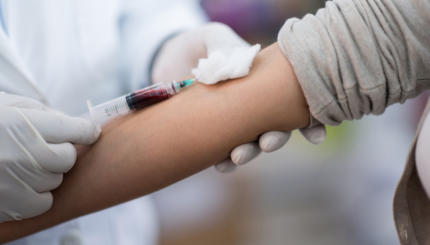The following diseases are included in the basic panel for genetic testing recommended by the Jewish Genetic Diseases Consortium. An additional 19 are included in an expanded 38-disease panel. Another 16 diseases are common among particular groups of and/or Jews. Information on the latter two groups of diseases are available on the JGDC website.
Bloom Syndrome
Bloom syndrome is a disorder that can result in short stature, skin rashes, sensitivity to sunlight, high-pitched voice, distinctive facial features, infertility and a heightened risk of several other diseases, including cancer, pulmonary disease and immune system abnormalities. Life span is often significantly shortened due to susceptibility to cancer and other complications. Carrier frequency is one in 134 Jews.
Further Resources:
National Institutes of Health
Bloom’s Syndrome Foundation
Bloom’s Syndrome Association
BloomSyndrome Foundation (Netherlands)
Bloom’s Syndrome Registry
Blooms Connect
Canavan Disease
Canavan Disease is caused by the deterioration of white matter in the brain, which in turn impedes the function of nerve cells throughout the body. Symptoms typically occur within the first nine months of life and include a failure to develop basic motor skills, enlarged head and poor muscle tone. Over time, seizures, difficulty in swallowing, paralysis and retardation can result. Affected individuals typically live through childhood only, though some have survived into adolescence and beyond. A milder and less common form of the disease features far less dramatic symptoms that are sometimes never recognized and do not appear to shorten lifespan. About 1 in 55 Ashkenazi Jews are carriers of the disease.
With your help, My Jewish Learning can provide endless opportunities for learning, connection and discovery.
Further Resources:
National Institutes of Health
Canavan Foundation
Canavan Research Foundation
Cystic Fibrosis
Cystic Fibrosis is a condition in which the body produces a thick mucus that can clog the lungs and impair organ function. Symptoms can include wheezing, chronic coughing and inflammation leading to breathing problems and bacterial infections in the lungs. Over time the condition can cause digestive problems and reduced pancreatic function. Improved treatments have led to increased lifespan in recent decades, with many sufferers in the United States now surviving into their 30s and 40s. Carrier frequency is about 1 in 24 Ashkenazi Jews and about 1 in 26 Sephardic/Mizrahi Jews.
Further Resources:
National Institutes of Health
Cystic Fibrosis Foundation
Boomer Esiason Foundation
Cystic Fibrosis (online community)
CF Living
Cystic Fibrosis Worldwide
Cystic Fibrosis-Reaching Out Foundation
Cystic Fibrosis News Today
Familial Dysautonomia
Familial Dysautonomia is a disorder that affects the autonomic nervous system, which controls involuntary actions, and the sensory nervous system, which controls activities related to the senses. The disorder features a wide range of symptoms that typically begin in infancy and increase in number with age. These include poor muscle tone, feeding difficulties, poor growth, lack of tears, frequent lung infections and difficulty maintaining body temperature. In older children, the disease can result in bed wetting, vomiting, reduced sensitivity to temperature and pain, poor balance, scoliosis, kidney and heart problems, and learning difficulties. Affected adults can suffer from lung and kidney problems and impaired vision. The disease results in shortened lifespan, with affected individuals born in 2006 projected to have a 50 percent chance of survival to age 40. About 1 in 31 Ashkenazi Jews are carriers of the disease.
Further Resources:
National Institutes of Health
Dysautonomia Foundation
National Dysautonomia Research Foundation
Familial Dysautonomia Now Foundation
Familial Dysautonomia Hope Foundation
Dysautonomia Youth Network of America
Familial Hyperinsulinism
Familial Hyperinsulinism is a condition that causes irregular levels of insulin, the hormone that controls blood sugar levels. Symptoms can occur very soon after birth, and can include lethargy, hypoglycemia, seizures and difficulty feeding. Repeated episodes of low blood sugar can lead to more serious complications. Treatment with drugs or glucose injections can help manage the disease. Surgery to remove all or part of the pancreas is also common. The carrier frequency for Familial Hyperinsulinism is about 1 in 68 Ashkenazi Jews.
Further Resources:
National Institutes of Health
Congenital Hyperinsulism International
Fanconi Anemia C
Fanconi Anemia C is one of several subtypes of a disorder that impairs the ability of bone marrow to produce new blood cells. Signs of the disease are often apparent at birth. Affected individuals often suffer from bone marrow failure, infertility, short stature, increased incidence of certain types of cancer, gastrointestinal difficulties and various physical abnormalities. Drugs and bone marrow transplantation are used to manage the disease, but most of those affected die in early adulthood. The carrier frequency among Ashkenazi Jews is 1 in 100.
Further Resources:
National Institutes of Health
Fanconi Anemia Research Fund
Gaucher Disease
Gaucher disease is the most common genetic disease affecting Ashkenazi Jews. The disease results from a specific enzyme deficiency that can impact many of the body’s organs and tissues. There are various types of the disease. The most common is Type 1, whose symptoms include enlargement of the liver and spleen, anemia, low red blood cell count, lung disease and bone abnormalities. Other forms of the disease affect the cardiovascular and central nervous systems. Symptoms can vary widely in intensity. Some of those affected with the more severe forms may suffer extremely shortened lifespans, while others can manage the disease successfully over the long term. The carrier frequency for Ashkenazi Jews is about 1 in 15.
Further Resources:
National Institutes of Health
National Gaucher Foundation
Children’s Gaucher Research Fund
Joubert Syndrome 2
Joubert Syndrome 2, also known as Cerebelloculorenal Syndrome, is a subtype of a condition whose symptoms include poor muscle tone, abnormal eye movements, intellectual disability and poor motor coordination. Though symptoms can vary, the condition is marked by the underdevelopment of the cerebellar vermis area of the brain, which controls balance and coordination. The condition can also be associated with kidney or liver failure. Symptoms typically begin in infancy. Treatment options are solely supportive and symptomatic. The carrier frequency among Ashkenazi Jews is 1 in 100.
Further Resources:
National Institutes of Health
Joubert Syndrome & Related Disorders Foundation
Lipoamide Dehydrogenase Deficiency (E3)
Lipoamide Dehydrogenase Deficiency (E3) is a condition caused by an enzyme deficiency that leads to the buildup of lactic acid in the body. The symptoms typically present in childhood and are quite varied, including serious fatigue, episodes of hyperventilation, vomiting and abdominal pain. The disorder can be fatal in childhood, though it can also often be managed through diet and immediate medical attention when lactic acid buildup occurs. The carrier frequency among Ashkenazi Jews is 1 in 107.
Further Resources:
National Institutes of Health
Genetic Disease Foundation
Maple Syrup Urine Disease (1B)
Maple Syrup Urine Disease is a disease characterized by deficiency in enzymes needed to break down certain amino acids. The disorder derives its name from the distinctive sweet odor of the urine of those affected. Symptoms typically begin shortly after birth and include irritability, poor feeding and lethargy. The disease can usually be successfully managed through a strict dietary regimen, but left untreated can lead to neurological damage, seizures, coma and death. The carrier frequency among Ashkenazi Jews is 1 in 97.
Further Resources:
National Institutes of Health
National Organization for Rare Disorders
MSUD Family Support Group
Mucolipidosis IV
Mucolipidosis IV is a disorder characterized by severe underdevelopment of intellectual and motor skills. Symptoms are usually apparent within months of birth. Many of those affected have limited or absent speech, impaired vision, difficulty walking independently, digestive problems and poor muscle development. Though many of those affected by the disease survive into adulthood, they may still have shortened lifespan. The carrier frequency among Ashkenazi Jews is 1 in 89.
Further Resources:
National Institutes of Health
National Organization for Rare Disorders
Mucolipidosis IV (ML4) Foundation
Nemaline Myopathy
Nemaline Myopathy is a disease characterized by muscle weakness, typically in the face, neck and other muscles close to the center of the body. Symptoms are generally present in childhood and can vary widely in intensity. In severe cases, weakness in the respiratory muscles can be life-threatening, but in most cases affected individuals can lead active lives. Carrier frequency in Ashkenazi Jews is 1 in 168.
Further Resources:
National Institutes of Health
National Organization for Rare Disorders
A Foundation Building Strength
Nemaline Myopathy Support Group
Niemann-Pick Disease
Niemann–Pick refers to a collection of metabolic disorders characterized by an enzyme deficiency that leads to the buildup of certain types of lipids in the body. Individuals affected with the most severe and most common form, Type A, typically develop an enlarged liver and spleen within the first three months of life, followed by a progression of other symptoms that normally lead to death within the first four years. Other subtypes generally develop later and are not as severe. Carrier frequency among Ashkenazi Jews is 1 in 115.
Further Resources:
National Institutes of Health
National Niemann-Pick Disease Foundation
Spinal Muscular Atrophy
Spinal Muscular Atrophy is a disorder caused by the loss of motor neurons in the spinal cord and brainstem. The disease has multiple types distinguished by the age of onset and the severity of symptoms. In the most severe forms, symptoms begin very early and often lead to death within several months to two years as a result of respiratory problems. With milder forms, symptoms begin later in childhood or even into adulthood and, depending on their severity, can sometimes permit a normal lifespan. All forms of the disease involve some degree of muscular weakness that can lead to atrophy as well as difficulty walking, breathing and eating. Carrier frequency is 1 in 41 for Ashkenazi Jews and 1 in 10 for Egyptian Jews.
Further Resources:
National Institutes of Health
Cure SMA
FightSMA
Spinal Muscular Atrophy Foundation
Spinal Muscular Atrophy
Tay-Sachs Disease
Tay-Sachs Disease is a disorder characterized by an enzyme deficiency that destroys neurons in the brain and spinal cord. The most common form of the disease begins within months of birth and entails the progressive loss of motor skills, neurodegeneration, seizures, blindness, spasticity and eventually total incapacitation and death. A far more rare form of the disease begins later in life, from childhood to adolescence and beyond, and the symptoms are milder, though they include poor coordination, tremors and slurred speech. As the disease progresses, it can lead to mental and behavioral abnormalities, including bipolar disorder and psychoses. Carrier frequency for infant onset Tay-Sachs among Ashkenazi Jews is 1 in 27.
Further Resources:
National Institutes of Health
National Tay-Sachs and Allied Diseases Association
Cure Tay-Sachs Foundation
Torsion Dystonia
Torsion Dystonia, also known as dystonia musculorum deformans, is characterized by muscle spasms, contractions, and tremors. Symptoms usually begin in early childhood and are progressive. Sometimes symptoms are isolated in one part of the body, and sometimes affect many. The disease is caused by a mutation in the TOR1A gene, but not all people with the mutation develop the disease (only 30-40%). Somewhere between 1 in 3000 and 1 in 9000 Ashkenazi Jews are affected by this disorder.
Further Resources:
National Institutes of Health
Usher Syndrome
Usher Syndrome is a disorder that affects nerve cells in the ear and photoreceptor cells in the retina. The disease is marked by total or partial loss of vision or hearing that worsens with time. There are several types of the disease. In Type 1, affected individuals are typically born with hearing loss and difficulty balancing due to abnormalities in the inner ear. In Type 3, vision and hearing loss typically begin later in life. Carrier frequency for Type 1F is 1 in 147 for Ashkenazi Jews and 1 in 120 Ashkenazi Jews for Type 3.
Further Resources:
National Institutes of Health
Usher Syndrome Coalition
Hear See Hope
Walker Warburg
Walker Warburg is a disease characterized by severe abnormalities in the muscles, brain and eye. Symptoms are typically evident very early in life and include severe retardation, small head, poor muscle tone, small eyes, blindness, seizures and feeding difficulties. Most affected individuals do not survive past the age of three. Carrier frequency is 1 in 120 for Ashkenazi Jews.
Further Resources:
National Institutes of Health
Based on information provided by the Jewish Genetic Diseases Consortium.


